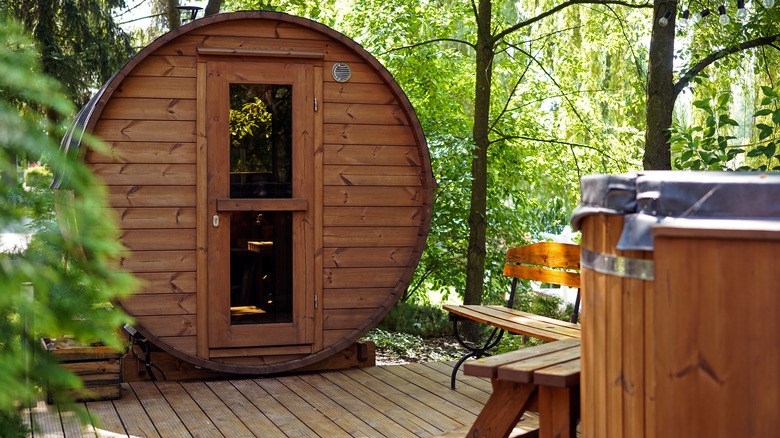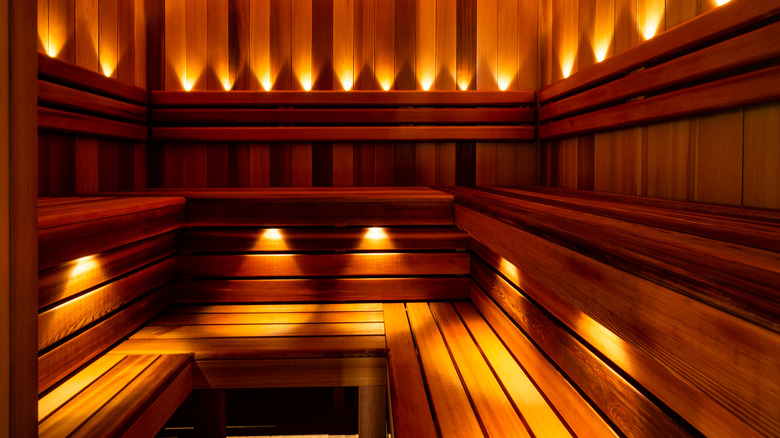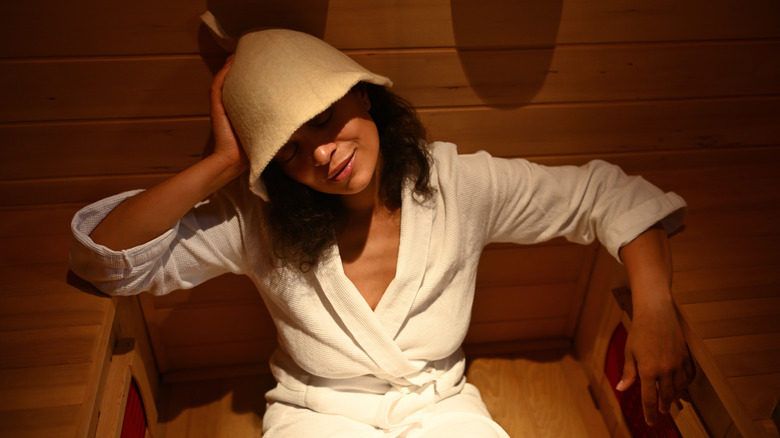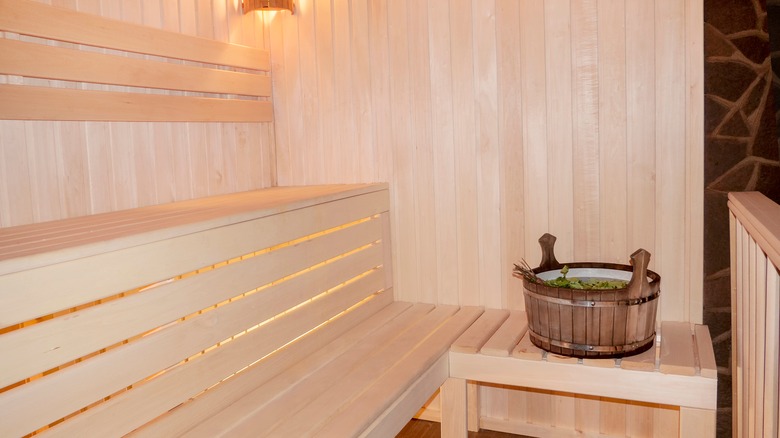How Much Does It Cost To Install A Sauna?
The benefits of spending time in a sauna are widespread. Users themselves report enhanced feelings of relaxation and pain relief (via Healthline). When used as a post-exercise therapy, sauna visits can help increase blood flow to muscles, tendons, and skin, producing a potent relief for strained muscles and joints. Indeed, research conducted by Joy Hussain at the Royal Melbourne Institute of Technology notes that "regular dry sauna bathing has potential health benefits," as a part of her conclusions in studying this surprisingly little-researched wellness routine, per the journal Evidence Based Complementary Alternative Medicine.
Daily Scandinavian reports that Scandinavian saunas date back as far as 7,000 BCE, and in these northern European climes, bathing in a sauna incorporates more than simply relaxation; it's a ritual experience full of history and tradition. In line with other science-focused publications, the Daily Scandinavian editorial team points to multifaceted wellness benefits that come primarily through the change in body temperature that occurs in one of these facilities. With a heightened body temperature, burning additional calories, natural circulation improvements, and a flush of the pores through increased sweat production all combine to make the experience highly enriching.
The best part of all of this is the cost involved in building an at-home sauna. Forbes Home estimates that the average sauna will set a homeowner back around $4,500, with high and low marks coming at $6,000 and $3,000, respectively.
Factors for cost
For a person who already pays to take advantage of this premium gym or rec center addition, a renovation project that brings the physical and mental wellness benefits directly into the home is a great option that will provide years of enjoyment. The first decision you'll be faced with as you approach the installation of a new sauna is the location you intend on building the facility. Homeowners have two main choices when it comes to this home upgrade: indoor and external sauna fabrication.
Indoor saunas provide an ease of access, but require additional details
An indoor sauna can be a great addition to an existing bathroom — or perhaps as a conversion for one of your home's bathrooms that sees little to no use. But ventilation requirements and the existing footprint of the home will mean that conversion costs can rise above the price tag for the installation of an outdoor unit that won't suffer from the same spatial and building constraints.
According to HomeAdvisor, the construction of an indoor sauna can realistically be accomplished in any part of the home that you might find useful, for instance in a walk-in closet, spare bedroom, or in the basement. Typically these start at around $3,000 for a basic model and can rise above $9,000 for more in-depth installations.
Outdoor construction offers a wealth of possibilities while demanding unique particulars
Building your new sauna as a standalone structure in the backyard is a great way to create a beautiful addition to the home. This choice will oftentimes reduce the overall cost of the project itself by removing the need to reimagine interior design and structure elements of your home, with a baseline price of around $3,500 to $5,000 for materials and installation included (via Costowl.com).
Of course, the final price of any addition will span a significant range depending on the size of the sauna (based in both square feet and the number of people you intend to be able to fit in the facility at any one time).
Additional costs
The selection of wood is one of the main factors that can move the needle on cost in a big way. Once you've decided on the location of your sauna, you can go about making an intelligent selection on the wood choice (or other materials that might make sense in your particular use case). In addition to the materials, you'll need to factor in operational costs, maintenance, and installation necessities, in order to complete the financial image of this new and exciting addition to the home.
Wood selection is an important first step in the right direction.
Selecting a wood that will make up your sauna is often the first decision you'll make after finalizing a location within your property for the new installation. Wood is a common choice because it's great for providing both insulation and heat absorption (via My Sauna World). Wood can be a fantastic visual element as well, and many saunas — both old and new — make use of a few highly popular wood choices that offer a blend of beauty and functionality.
Cedar
Cedar is a highly sought after wood selection in the construction of saunas and nearly every other type of furniture, decoration, and more. For one, there's cedar trees from Lebanon, a popular selection. However, other cedar varieties haven't been so systematically deforested and make for a fantastic wooden foundation for the construction of new home saunas. Western red cedars and eastern white cedars are favorites among manufacturers and home DIY builders. According to My Sauna World, cedarwoods offer virtually unparalleled durability and are perfect for outdoor builds because they are resistant to rot and decay. Additionally, the interior uniformity of the grain helps combat physical changes that can occur throughout the extreme temperature swings that the fixture will experience as a result of normal use.
Hemlock
Hemlock is another highly prized wood choice for the construction of saunas. This is a favorite because of its dense pattern and heavy weight, according to Saunas & Stuff. Hemlock is cheaper than cedar, but it presents a comparable, if not better, shrink resistance than cedar or any other construction material. Hemlock saunas offer a creamy, light-colored wood grain pattern that fits right in regardless of the location you select for the installation. Likewise, the weight and strength of the material means that lighter overall hardware can be used to complete the construction.
Work with a professional to ensure proper installation
A professional is often the best way to go for many home improvement projects, and with the addition of a sauna in your home, this is no different. Many homeowners enjoy a level of confidence in the assembly or construction process of many at-home improvements, but the hookups that involve plumbing and particularly electrical wiring should nearly always be left to a professional, as reported by The Spruce.
The dangers of an improperly installed electrical circuit can put you and everyone else in your home at risk, and these dangers don't subside after the installation is completed. A poorly finished electrical system is a tinderbox just waiting for the devastating spark to set off a potentially catastrophic chain reaction. Working with an electrician is the only way to eliminate danger during the initial hookup and to mitigate long term hazards as well. According to HomeAdvisor (per Forbes), hiring an electrician will typically cost $50 to $100 per hour, but this expense is well worth the price tag to ensure safe installation and long-lasting performance.
Main types of saunas
Dry saunas are common across both commercial and home applications and are the most commonly seen variety on the market, as noted by Angi. A dry sauna uses electric or gas heating to introduce a dry heat into the room, and steam is not a part of this equation. Dry saunas are often easier to manage for homeowners because there is less maintenance work involved in cleaning and care as a result of the lack of additional moisture that a wet sauna or steam room will add into the mix.
Steam room or wet sauna
The ability to add steam is an added feature in many saunas though. Angi reports that this add-in may only cost around $100 or $200 more than the traditional dry sauna variety, so it's something that you may want to consider for enhanced versatility. With the added steam production capability, you can focus on the pore clarity and congestion relief that are built into the steam feature (via Healthline).
Infrared saunas provide a heat-based wellness boost without the intense temperatures
The infrared sauna is a technology-driven advancement in the world of heat therapies. According to the Mayo Clinic, instead of heating the air in a dedicated sauna room, an infrared sauna uses light to heat your body rather than the surrounding space. These are perfect for those who aren't able to withstand the intense temperatures of a traditional sauna experience but still want to enjoy the wellness benefits and overall experience that this remedy has to offer.
Outdoor sauna
An outdoor sauna heated with the use of stone and fire is the traditional setting for this experience (via Infrared Sauna). Placing a wooden sauna in an outdoor space on your property will give you the classical feel and is great for homeowners with limited indoor space constraints. An outdoor sauna is a standalone construction that won't alter the layout or routine of your home's environment, and making adjustments to account for increased use, adding a steam function later on, or even replacing elements of the sauna or opting for a different model altogether is far simpler with this type of unit.
Why you need a sauna
A sauna is a great addition to the typical American home these days. With more interest in the use of these wellness tools, an at-home sauna can help you bring a new level of health, wellness, and mindfulness into your everyday life.
A sauna can boost resale value and market interest as a unique home feature
What's more, many owners see this feature as a unique selling point as they consider listing their property and moving on to a new home that better suits their evolving lifestyle needs. It can be difficult to assess the return on investment that a sauna brings on the open market because every buyer will be a little bit different. However, by highlighting the inclusion of this home feature, you can be sure to draw a broad interest from the real estate market for those who are on the hunt for the kind of lifestyle you've built for yourself in the property. Alternatively, breakdown of an existing sauna typically runs a homeowner around $75 to $100 per worker and hour, meaning disposal or transport of your existing unit to a new property likely won't break the bank (via HomeAdvisor).
Taking advantage of myriad health benefits is simple with an in-home sauna
The health benefits that a sauna can provide are numerous and potent. A multinational research study (published by JAMA Internal Medicine/JAMA Network) studying 2,315 Finnish men aged 42 to 60 found a significant link between the use of regular sauna baths and a reduction in the incidence of heart disease and related causes of death. A healthy heart is a key feature in a long and healthy life, making the use of a sauna something that everyone should consider in their wellness routine.
The trend is catching on, but with the typical sauna existing as a feature of community rec centers or gyms, a user is often forced to share this space with others, which may function as another benefit in creating a communal atmosphere or reduce the enjoyment that a user experiences. Certainly, the ability to incorporate meditation and relaxation habits into routine sauna use benefits from a solo experience in the facility. So, bringing this option into your private living space can act as a great change of pace for those seeking to withdraw from the public bathing arena while enjoying the relaxing effects native to the sauna environment.
According to Alex Fergus, an ISSN certified sports nutrition specialist and Australian bodybuilding champion, the heat exposure that's an integral component of any sauna experience can energize the natural production of growth hormone in the body. This is a critical hormone for recovery and repair after a workout, injury, or physical trauma, and it plays a role in healthy fat loss as well.
Benefits of an in-home sauna
According to Men's Health, the use of sauna treatments after a workout can boost the physical gain felt with each gym session. Saunas can also offer excellent skin clarification as well as heart and muscular wellness benefits to users who use a sauna on a regular basis.
Skin clarity is a natural outcome
It's a common myth that pores can forced to open and close, according to BioClarity. While steam and heat-related treatments might not change the overall size of your facial pores, the use of steam is indeed integral to the general health of your skin and the clarity of pores that exist across your dermal layer. Clogged pores appear more visible, and so working in natural remedies that can help clean out irritants is a great way to regain radiant and healthy skin that looks and feels fantastic at all times.
Sweating is one of the primary methods of flushing dirt, oils, and other materials from your skin — and is a core ally in those battling acne, according to Bustle. Saunas provide a one of a kind approach to working up a healthy sweat across every inch of your skin. Not only does a sauna session help clear out foreign irritants from skin, it can be great for enhancing natural collagen production and dead skin cell removal (via Men's Health).
Muscular maintenance is enhanced by regular sauna usage
A 2021 study published in Experimental Gerontology (via Science Direct) shows a correlation between the maintenance of muscle mass and the regular use of a sauna. Researchers Rhonda Patrick and Teresa Johnson cite a mimicking of "physiological and protective responses" in the sauna setting that occur during exercise as a direct means of understanding this phenomenon. In the gym, a lifter works to build a stronger muscular response through the repetition of targeted muscle contractions and subsequent controlled release. But muscle fibers don't just respond to direct stimulation (in the form of a decision to lift, push, or pull an object); instead, they function as active participants in daily life and are intimately affected by the aging process, injury, disease, and other external factors that can change a physical body.
Heat treatment helps to naturally sooth aching muscles, but it can also induce natural mitochondrial biogenesis, or the subdivision of mitochondrial cells that make up the muscle tissues in the human body (via the NIH). As a result, routine sauna treatments can act as a low-intensity workout all on their own. When used in conjunction with regular exercise, the difference is often noted in dramatic fashion.
Relaxation is a core element in the use of saunas
Sauna users often report a powerful feeling of relaxation during and after a session in the heated space. Saunas are well known for their relaxing effect, and the bodily reaction to the heated environment includes a natural feedback that releases tension across all muscle groups, improves feelings of happiness, and pumps up blood vessels, per Healthline.
The relaxing effects of a sauna can translate into a variety of tertiary benefits that aren't constrained by the immediate change that occurs while soaking in the heat. Meditation is a common practice among those who routinely use a sauna. Finnleo, a well-known sauna maker, reports that bathing in a sauna increases blood flow to the brain as well as the muscular system, making for a powerful setting to improve mindfulness and take advantage of heightened meditation opportunities. Finally, meditation is a proven means of creating expanded focus across all aspects of daily life, not just in the moment: It only takes a few minutes to make a huge difference in each and every day (via Mayo Clinic).





